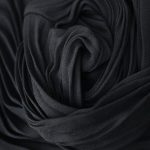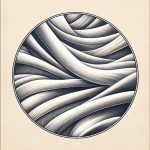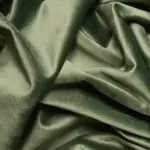When you choose poplin fabric, you're opting for a material that's often praised for its moderate wrinkle resistance. This can be a practical advantage, especially if you prefer garments that maintain a crisp look with minimal upkeep. However, understanding how to care for poplin properly is essential to maximizing its benefits. Are you curious about what specific care techniques can enhance its durability and appearance? Discovering the nuances of fabric maintenance might change the way you approach your wardrobe.
Table of Contents
Key Takeaways
- Poplin is generally wrinkle-resistant due to its tight weave and often synthetic blends, which help maintain a crisp appearance.
- Fabrics labeled "wrinkle-resistant" have likely undergone special treatments to enhance their resistance to creasing.
- Compared to cotton and linen, poplin offers a better balance of comfort and wrinkle resistance, requiring fewer touch-ups.
- To maintain its wrinkle-resistant properties, wash poplin in cold water and iron on medium heat with steam if needed.
What Is Poplin Fabric?
Poplin fabric is a tightly woven material known for its smooth texture and lightweight feel, making it a popular choice for shirts and dresses. You'll appreciate how it drapes effortlessly, allowing for comfortable wear throughout the day.
Originating from the French word 'papeline,' poplin was originally made from silk and wool, but today it's commonly crafted from cotton or a blend of fibers. This versatility provides you with a variety of options depending on your needs.
When you choose poplin, you're opting for a fabric that's not only stylish but also practical. Its structure gives it a crisp appearance, which is perfect for both casual and formal outfits. You can find poplin in various colors and patterns, allowing you to express your personal style easily.
As you explore your wardrobe, you'll notice how poplin blends well with other materials, enhancing your overall look.
In addition to its aesthetic appeal, poplin fabric is generally easy to care for, making it a smart addition to your closet. Whether you're dressing up for work or keeping it casual, poplin's lightweight nature ensures you stay comfortable and chic.
Characteristics of Poplin
Known for its durability and versatility, poplin features a fine, tightly woven structure that contributes to its smooth finish and lightweight feel. This fabric is often made from cotton, polyester, or a blend, making it suitable for various applications, from shirts to dresses. You'll appreciate its soft texture and breathable qualities, which make it comfortable to wear year-round.
Here's a quick overview of poplin's characteristics:
| Feature | Description |
|---|---|
| Texture | Smooth and soft to the touch |
| Weight | Lightweight, ideal for layering |
| Breathability | Excellent airflow for comfort |
| Durability | Strong and resistant to wear |
| Versatility | Suitable for formal and casual wear |
With these characteristics, poplin stands out as a go-to fabric for many wardrobe staples. Whether you're dressing up for a special occasion or looking for everyday comfort, you can trust poplin to deliver both style and practicality. Its ability to hold color well also means your garments will look vibrant and fresh, ensuring your investment lasts through countless wears.
Wrinkle Resistance Explained
When it comes to wrinkle resistance, fabric composition plays a crucial role in how well your clothes maintain their shape.
You'll want to consider care and maintenance tips to keep your garments looking fresh and crisp.
Plus, comparing wrinkle-resistant fabrics with others can help you choose the best option for your wardrobe.
Fabric Composition Matters
Understanding how different fabric compositions affect wrinkle resistance can help you choose the best materials for your wardrobe.
Fabrics like cotton, while breathable and comfortable, are notorious for wrinkling easily due to their natural fibers. If you want a smooth look without constant ironing, you might want to avoid 100% cotton options.
Synthetic fibers, such as polyester and nylon, are often blended with natural fibers to enhance wrinkle resistance. These blends not only reduce wrinkles but also add durability. For instance, a cotton-polyester blend combines the softness of cotton with the resilience of polyester, giving you a fabric that's less prone to creasing.
When you're shopping, keep an eye out for labels that specify “wrinkle-resistant” or “easy care.” These fabrics often undergo treatments designed to minimize wrinkling. Additionally, performance fabrics designed for activewear usually have moisture-wicking properties and are engineered to resist wrinkles.
Ultimately, selecting the right fabric composition is key to maintaining a polished look. By understanding how various materials respond to wear and tear, you can make smarter choices that save you time and effort in your daily routine.
Care and Maintenance Tips
To keep your clothes looking their best and minimize wrinkles, it's essential to follow specific care and maintenance tips tailored to each fabric type.
When it comes to poplin, treating it right can enhance its natural wrinkle resistance. Always check the care label for washing instructions; most poplin garments are machine washable in cold water. Use a gentle cycle to avoid excessive agitation, which can lead to wrinkles.
After washing, promptly remove your poplin clothes from the washer to prevent creasing. If you can, hang them to dry instead of using a dryer, as the heat can set wrinkles. If you must use a dryer, opt for a low heat setting and take them out while they're still slightly damp.
When it comes to ironing, use a medium iron setting and a bit of steam for stubborn wrinkles. If you're short on time, a fabric spray can help smooth things out quickly.
Lastly, store your poplin items properly. Hanging them in a breathable closet space helps maintain their shape and minimizes the chances of wrinkles forming.
Following these tips will ensure your poplin looks fresh and crisp every time you wear it.
Comparing With Other Fabrics
Poplin's wrinkle resistance stands out, but it's important to compare it with other fabrics to understand how they each handle creasing.
When you think about fabric choices, you'll find that not all materials are created equal. Some fabrics wrinkle more easily, while others are designed to resist creasing better than poplin.
Here's a quick comparison of poplin against three other popular fabrics:
- Cotton: While cotton is breathable and comfortable, it tends to wrinkle easily, often requiring ironing after washing.
- Polyester: Known for its durability, polyester is highly wrinkle-resistant and often used in blends to enhance the wrinkle resistance of other fabrics.
Care Instructions for Poplin
Caring for poplin fabric is simple, and following a few easy steps will keep it looking fresh and vibrant. First, check the care label for specific instructions, but generally, you can machine wash poplin in cold or warm water. Using a gentle cycle is best to prevent any unnecessary wear. Avoid bleach, as it can damage the fibers.
After washing, you can tumble dry on low heat. If you prefer air drying, hang your poplin items to prevent wrinkles. It's a good idea to remove them from the dryer while they're still slightly damp to make ironing easier.
When it comes to ironing, set your iron to a medium heat. Press the fabric while it's still a bit damp for the best results. If needed, you can use a steam setting to tackle stubborn wrinkles.
For storage, hang your poplin garments to maintain their shape, or fold them neatly to avoid creases. By following these simple care instructions, you'll ensure your poplin remains bright and comfortable, ready for any occasion. Enjoy the ease of maintaining this versatile fabric!
Comparing Poplin With Other Fabrics
When you consider fabric options, comparing poplin to cotton, linen, and synthetics can help you make the right choice for your needs.
Each fabric has its unique properties, so understanding these differences is key.
Let's explore how poplin stacks up against these popular materials.
Poplin Vs. Cotton
Poplin and cotton both offer unique qualities, but understanding their differences can help you choose the right fabric for your needs.
While cotton is a natural fiber known for its softness and breathability, poplin is a tightly woven fabric that's often made from cotton or a cotton blend. This distinction affects the feel, durability, and care of each fabric.
Here are some key points to consider:
- Texture: Poplin has a smooth, crisp texture, making it ideal for dress shirts and tailored clothing, while cotton can vary from soft to slightly coarse depending on the weave.
- Durability: Poplin's tight weave gives it a slightly more durable quality compared to standard cotton, which can be more prone to wear and tear over time.
Poplin Vs. Linen
While both poplin and linen are popular choices for clothing, their unique characteristics can significantly impact your comfort and style.
Poplin, a tightly woven fabric, offers a smooth texture and is lightweight, making it great for a polished look. It's versatile, often used for dress shirts and casual wear, and it tends to resist wrinkles better than linen, so you won't have to worry as much about touch-ups throughout the day.
On the other hand, linen is known for its breathability and moisture-wicking properties, making it ideal for hot weather. It has a more textured feel, which can lend a relaxed, laid-back vibe to your outfits. However, linen wrinkles easily, which some people love for its natural, lived-in look, while others find it frustrating.
When choosing between poplin and linen, consider your needs. If you prioritize a crisp, structured appearance, poplin might be your best bet. But if you want comfort and breathability, especially in summer, linen could be the way to go.
Ultimately, each fabric has its strengths, so pick what aligns best with your style and lifestyle.
Poplin Vs. Synthetics
Understanding the differences between poplin and synthetic fabrics can help you make informed choices for your wardrobe.
Poplin, a cotton or cotton-blend fabric, offers breathability and a soft touch, making it comfortable for everyday wear. In contrast, synthetic fabrics like polyester and nylon provide unique benefits but come with their own drawbacks.
When comparing poplin to synthetics, consider these key points:
- Breathability: Poplin allows air circulation, keeping you cool in warm weather, while synthetics can trap heat and moisture.
- Care: Synthetic fabrics often resist wrinkles and stains, requiring less ironing and maintenance compared to poplin, which may need more care to maintain its crispness.
Ultimately, your choice between poplin and synthetics depends on your lifestyle and preferences. If you value comfort and sustainability, poplin might be your go-to. However, if you prioritize low-maintenance and durability, synthetic options could suit you better.
Tips for Maintaining Poplin
To keep your poplin looking fresh and vibrant, regular maintenance is essential.
Start by washing your poplin items in cold water to prevent fading and shrinking. Use a gentle detergent, as harsh chemicals can damage the fabric's fibers. If your poplin is white or light-colored, adding a little vinegar can help maintain its brightness.
When it comes to drying, air dry poplin items whenever possible. If you must use a dryer, opt for a low heat setting to reduce the risk of wrinkles. Remember, poplin tends to wrinkle easily, so you might want to remove it from the dryer while it's still slightly damp to make ironing easier.
Iron your poplin on a low to medium setting, and use steam for best results. If you don't want to iron, hanging your poplin garments immediately after washing can help minimize wrinkles.
Frequently Asked Questions
Can Poplin Fabric Shrink After Washing?
Yes, poplin fabric can shrink after washing, especially if it's made from cotton. To minimize shrinkage, wash it in cold water and avoid high heat when drying. Always check the care label for specific instructions.
Is Poplin Suitable for Sensitive Skin?
If you have sensitive skin, poplin's smooth texture and breathable nature can work well for you. Just make sure to wash it properly to avoid irritants, and you'll likely enjoy wearing it comfortably.
How Does Poplin Compare in Breathability to Cotton?
Poplin offers decent breathability, though cotton generally excels in this area. If you prioritize airflow for comfort, you might prefer cotton, but poplin still provides a lightweight option for various warm-weather situations.
What Types of Garments Are Best Made From Poplin?
Poplin's lightweight and smooth texture makes it ideal for shirts, blouses, dresses, and even tailored pants. You'll appreciate its versatility and comfort for both casual and formal occasions, ensuring you look polished and stylish.
Is Poplin Available in Various Colors and Patterns?
Yes, poplin's available in a wide array of colors and patterns. You'll find everything from vibrant hues to subtle shades, plus various prints that suit your style, whether for casual wear or formal occasions.
- What Is Spunlace Nonwoven and Where Is It Used? - July 11, 2025
- A Technical Guide to Meltblown Nonwoven Manufacturing - July 11, 2025
- The Pros and Cons of Nonwoven Fabrics: A Balanced View - July 11, 2025







